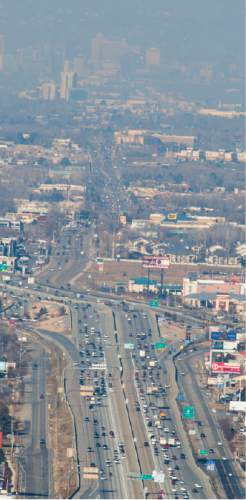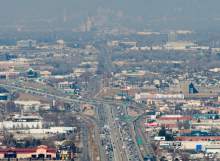This is an archived article that was published on sltrib.com in 2015, and information in the article may be outdated. It is provided only for personal research purposes and may not be reprinted.
Utah's emission tests are not fool-proof.
Catalytic converters can be hacked after an emission inspection to improve performance. Inspection forms can be tweaked. And equipment can break down after the fact, spewing smoke from a vehicle with a current inspection sticker.
State Rep. Patrice Arent is sponsoring legislation this year to give air quality watchdogs more leverage over emissions cheaters. The Division of Motor Vehicles (DMV) could suspend a vehicle's registration if police or local health department inspectors believe it could not pass an emissions test.
Arent's bill is not aimed at those who cannot afford to fix a car out of compliance, although low-income drivers still could find their registrations in trouble.
The focus "is individuals who are thumbing their noses at the law while the vast majority are doing what they can to operate a clean-running vehicle," said Gary Edwards, executive director of the Salt Lake County Health Department.
HB110 is among several measures for the 2015 Legislature targeted at improving Wasatch Front air quality. But, Arent says, much of the effort this year will focus on funding — for research, incentives to install cleaner technology and equipment like natural gas school buses.
"The important things aren't going to be bills, but are going to be funding," the Millcreek Democrat said.
Many air quality watchers argue Utah needs its own research programs because the Wasatch Front's air quality issues are so different from those in other western metropolises.
The $1 million lawmakers set aside last year funded 14 air quality projects, chosen from 40 applications.
Bryce Bird, director of the Utah Division of Air Quality, wants to build on that with an ongoing air quality appropriation.
At a University of Utah workshop earlier this month, Bird said that regulators cannot effectively address the state's air quality crisis unless they can identify the best pollution controls and inversion-fighting strategies.
"We need the ability to be sure that as we make decisions, we aren't making the problem worse or just chasing the problem down the road," he said.
Arent agrees that an investment in scientific research is necessary for crafting effective legislation.
"I want real data, real information before we try to pass legislation," she said. "We need to know it will make a difference and it's not just feel-good legislation."
This year's legislative session is not expected to be filled with the glut of air-quality bills introduced last year. The most prominent measures for 2015 are retreads of bills that stalled a year ago.
Rep. Rebecca Edwards, R-North Salt Lake, has resurrected her call to authorize the Division of Air Quality (DAQ) to enact rules that are tougher than federal regulations, while Sen. Gene Davis, D-Salt Lake City, wants to repeal the prohibition that has long prevented DAQ from enacting stricter rules. Both bills hit a wall in 2014.
Another idea that is back is replacing older, dirty diesel school buses. Rep. Stephen Handy, R-Layton, wants to help school districts buy cleaner natural gas versions and install compressed natural gas (CNG) fueling stations for them.
Handy's bill would earmark $20 million from the state's Education Fund for bus upgrades. School districts and charter schools would be invited to seek grants for replacing buses built before 2002 and equipping their shops to service and fuel CNG buses.
Another bill would convert an expired tax credit into a rebate for purchasing a low-emission vehicle or converting an existing vehicle.
The clean-air group HEAL Utah is most hopeful about Edwards' legislation and the so-called "local option" bill, which would allow cities and counties to bump up sales taxes to fund public transportation.
"They both failed late in the session [last year] and they are both a big deal," said HEAL executive director Matt Pacenza. "If every city took advantage [of the proposed local option], it could result in $70 million a year — primarily for buses and bus routes."
Edwards' and Davis' proposals have sparked controversy because critics say they could enable a future "rogue" Air Quality Board to impose unreasonable regulations.
But Edwards has put safeguards in her bill so that tighter air rules would have to be grounded in reliable data. The bill's supporters point to Utah weather and topography that combine to create air quality problems that are acute and completely different than anywhere else in the country.
"This requires some flexibility and innovation as we create Utah's solution," Edwards said last year during an interim session. "It allows for local decision-making and control to meet our local needs. This is an example of how Utah can be more effective than a one-size-fits-all, federal solution."
Vehicles account for most of Utah's air pollution, both ozone in the summer and particulate in the winter. Emission inspection programs are vital to softening tailpipe impacts by ensuring that catalytic converters function properly, according to Richard Valentine, director of the Salt Lake County Health Department's air quality bureau.
In Salt Lake County, more than 700,000 emissions inspections are completed annually at 440 stations. Between 7 and 10 percent of the cars fail and are denied renewed registrations until they can pass.
But an unknown number of motorists choose to disable their catalytic converters by installing special equipment that allows exhaust to bypass the catalyst. The converter can be reactivated so the vehicle can pass an inspection. Then, drivers promptly disable the converter.
Edwards says it's easy to spot the violating vehicles because they tend to belch black smoke when they accelerate.
Emitting visible smoke is a violation of state law and police can ticket drivers, but that's about it.
Arent's bill would address the compliance gap by requiring the police to forward the ticket to the DMV.
"If someone looks like their vehicle is out of compliance, they will have a chance to fix it," Arent said. "We don't want these vehicles on our roads because they are so polluting."
A companion bill, HB17, from Perry Republican Rep. Lee Perry, would toughen penalties for drivers whose cars emit visible exhaust.
Salt Lake County now provides financial assistance to low-income motorists to fix emissions problems that turn up on inspections. The Utah Clean Air Partnership provided enough money this year to help about 60 county residents.
Twitter: @brianmaffly





